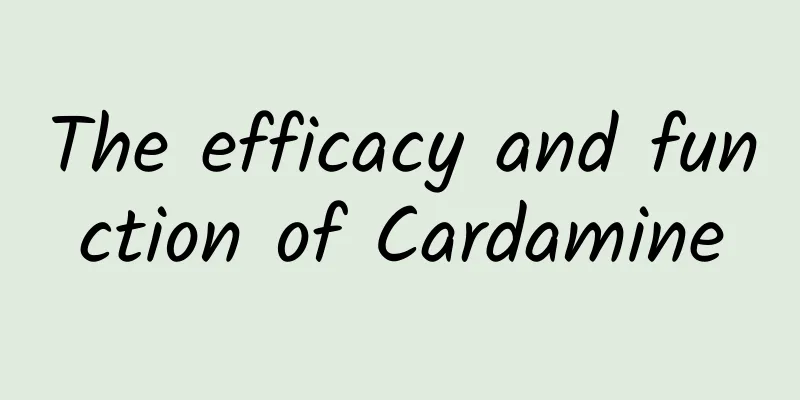The efficacy and function of Cardamine

|
There are so many medicinal herbs in the world, and it is inevitable that there are some that we are not familiar with. But as long as we have the spirit of learning throughout our lives, I believe we can slowly learn more medical herbs. So do you know about the medicinal herb Cardamine catarrhalis? [Alias] Water vegetable, water flower vegetable. [Source] Medicinal material source: the whole herb of the cruciferous plant Cardamine spp. [Original form] Cardamine is an annual or biennial herb, 20-60cm tall. The stem is erect, unbranched or sometimes branched at the top, with grooves on the surface, a few short hairs or no hair. Pinnate compound leaves; basal leaf petiole 1-3cm long, margin usually with short soft hairs, slightly enlarged at base, with 1 pair of stipule-like ears; 2-8 pairs of leaflets, terminal leaflet ovate, 6-13mm long, 4-8mm wide, margin with irregular blunt-toothed shallow lobes, petiolules prominent, lateral leaflets similar to terminal ones, gradually smaller from top to bottom, usually born in the lowest 1-2 pairs nearly lanceolate, entire, all with prominent petiolules; stem leaves petiolate, base also has amplexicaul linear ears, 3-8mm long, 5-8 pairs of leaflets, ovate, lateral leaflets similar to them, but smaller; uppermost stem leaflet leaflets narrower, margin less toothed or nearly entire; all leaflets scattered with short soft hairs, sometimes glabrous, margins all with ciliate margins. The raceme is terminal or axillary, with many small flowers, which extend during the fruiting period; there are 4 sepals, which are oblong; there are 4 petals, which are white, narrowly oblong, 2-3mm long, and slightly narrow at the base; there are 6 stamens, 4 long and 2 short, the long stamens are 2.8-3mm long, and the short stamens are about 1.8mm long; there is 1 pistil, the ovary is columnar, the style is extremely short, and the stigma is slightly wider than the style. The siliques are linear, slightly flat, 20-28mm long, with glabrous lobes that split elastically from bottom to top when ripe. The seeds are oval, 1-3 mm long, brownish yellow, with very narrow wings on the edges. The flowering period is from April to June, and the fruiting period is from May to July. [Habitat distribution] Ecological environment: Growing on hillsides, roadsides, valleys, waterside or shady wetlands between 150-3500m above sea level. 【Properties】 Characteristic identification: The roots are slender. The stem is single or branched at the top, 20-50cm long; the surface is yellow-green with fine grooves; it is brittle and easy to break. The odd-pinnate compound leaves are mostly wrinkled. When flattened, the base of the basal leaves' petioles are slightly enlarged, and the sides are narrowly lanceolate and ear-shaped, clasping the stem. There are 2-8 pairs of leaflets, which are elliptical, with irregular obtuse fissures on the edges, acute tips, and cuneate bases; the base of the stem leaves' petioles have linear lobes with ciliate margins on both sides, acuminate tips, and 5-8 pairs of leaflets, which are ovate-lanceolate and obtusely fissures. The inflorescence is a raceme with small yellowish-white flowers or siliques. The siliques are linear and slightly flat, 2-2.8 cm long and about 1 mm wide. When the fruit is ripe, the sylvian fruit splits elastically from bottom to top, with one row of seeds in each locule. The seeds are oval, 1-3 mm long, brownish yellow, with very narrow wings on the edges. It has a light fragrance and a light taste. 【Nature and flavor】 Light; neutral 【Functions and indications】Promote blood circulation and regulate menstruation; clear away heat and detoxify; promote diuresis and relieve stranguria. Mainly used for irregular menstruation, carbuncle, and stranguria [Usage and Dosage] For oral use: decoction, 15-30g. For external use: take appropriate amount and mash it for application. 【Excerpt】 Chinese Materia Medica Through the above introduction, let us understand the relevant knowledge of Cardamine elasmolyticus. If we can give full play to the efficacy of Cardamine elasmolyticus, it can help us solve some physical diseases. Therefore, many people regard it as their own health care choice. |
<<: The efficacy and function of the yindi fern in East China
>>: The efficacy and function of yellow back grass seedlings
Recommend
The efficacy and function of puffer fish liver oil
Pufferfish liver oil is one of the common traditi...
The efficacy and function of cascara
I believe many people are familiar with the Chine...
Some people are alive, but their butts are already "dead"...
Work, work, I sit when I go to work, sit all day,...
The efficacy and function of Trichoderma polycapsularis
There are so many medicinal herbs in the world, a...
Identification method of wild Cistanche deserticola
In life, many people buy Cistanche deserticola to...
China's "compound eyes": tracking "uninvited guests" in space
If an asteroid hits the Earth one day, is it poss...
How to eat wet Gastrodia elata?
Because people don't understand Chinese medic...
Peach Blossom Princess Ejiao Cake
Peach blossoms have a very good beauty-enhancing ...
You'll be shocked at first glance! There are so many dangers hidden in the kitchen!
Expert of this article: Chu Yuhao, PhD of Beijing...
Frommer's: 2012 Tourism Digital Marketing Trends Report
In 2012, two-thirds of travel companies plan to s...
The "four-step" process of adjusting attitude, descending and parachuting to land analyzes the return process of Shenzhou XII!
Produced by: Science Popularization China Produce...
What is the value of Astragalus membranaceus?
Astragalus is a very familiar and frequently used...
The efficacy and function of blue round trevally
Blue round scad is a medicinal material that can ...
How was the world's largest volcano formed? Chinese scientists propose a new model for the formation of submarine volcanoes!
Recently, Zhang Jinchang, a researcher at the Sou...
The efficacy and function of mountain tangerine abacus
Traditional Chinese medicine is very helpful in t...









